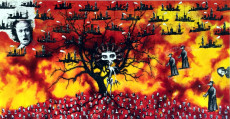
What does the visible hide?

A mental universe. This is the meaning of creating a painter's work according to René Magritte.
But with his period of 'cow painting' that came out of nowhere in the 1940s, Magritte began to play the 'Renoir', as Beaux-Arts points out. Or even "Matisse" at times. Enough to make André Breton realise that "this is not" a painting. Or at least not a surrealist painting. Surimpressionist? Scandals, threats, insults. The French branch of the movement, under the aegis of its rigorous "pope", could not recognise itself in the exuberant colours of these smeared imbecilities born of a great assumed nonsense. It was deliberate and calculated.
It was on the occasion of his first personal Parisian exhibition that the king of images ostensibly made to signify conceived this insane project. Do everything but Magritte. He is said to have experienced great joy and an unprecedented sense of freedom. But surrealism was no longer there to laugh at these potato jokes. Intelligent surrealist art took itself seriously. What remains today, with the benefit of hindsight, of the problematic underlying this aesthetic crisis?
First of all, it should be noted that if Magritte seems to have betrayed Magritte, it is first of all in his style. He no longer paints with the same brush. But the spirit remains unchanged. Like this unique way of writing sentences with a brush.
Today, such a difference would be even worse. It would be as if Soulages had taken on the role of Di Rosa for the duration of an exhibition. The art of a creator is totally equated with the plasticity of his or her work. This is a misguided approach to Magritte, whose aim was to paint an apple or a man in a bowler hat in a sufficiently realistic style to ensure immediate recognition. That is all.
Magritte does not paint beings, places and objects, in short things, he assembles signs as harmoniously as possible on a canvas. Technically, this is even more limited than Hopper. But here, as there, it is not the illusion of reality that is sought. The feeling of reality is enough. It is surprising that the differences in artistic policy prevented the French Surrealists from judging the shameful productions of their Belgian friend on levels other than mimesis and plasticity.
But in the end, what are the known painters left in the Surrealist section who have been spared by history? Dali, Chirico...Magritte! Not exactly the hardcore fundamentalists of the party embodied by Breton. In the end, it all depends on how you define Surrealism.
If we go back to its source, we necessarily come across this definition of surrealist beauty that Lautréamont gave: "Beauty like the chance meeting on a dissection table of a sewing machine and an umbrella". This is the very definition of Magritte's pictorial art, and particularly of his "cow painting", which was devised to counter the anti-Belgian snobbery of the Parisian beau monde with derision.
To conclude on this "intelligent painter", it is good to go back to where the Art Press article begins. For there are few painters who deserve to have Ferdinand de Saussure's theory of the sign quoted about them, as does Beaux-Arts. It would surely be good today if our artists knew how to differentiate between the signifier and the signified of their artistic gesture, just as they do with blue and red. This is the whole problem of "intelligent painters". They show us in a hollow way those who are not.
Illustration: René Magritte - The Pope's Crime - 1948





































































